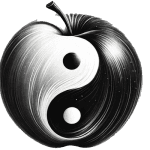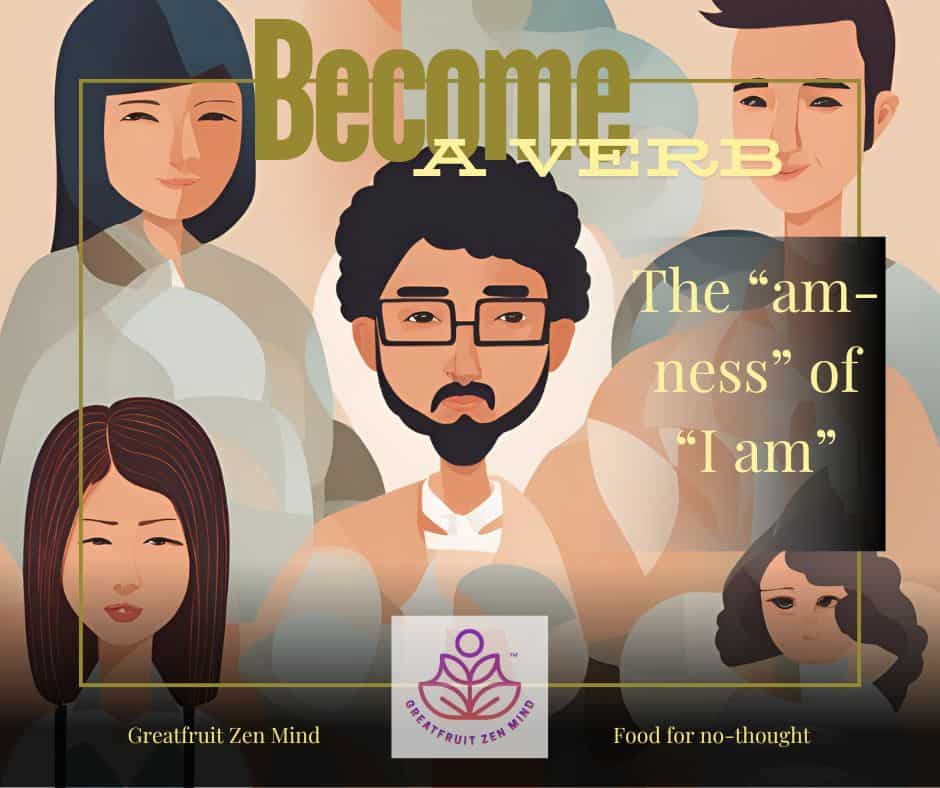Read time 5 minutes. Become a Verb is a stand alone article in our Who Am I series.
Our exploration into the practice of self-inquiry has stretched across ten lessons—sometimes direct, sometimes meandering, always circling back to the same essential question: Who am I?
The aim has not been to collect more theories but to transform intellectual understanding into lived experience. And now, as the thread is drawn together, the invitation is clear: when asking this question, do not go looking for answers. Instead of answers, become a verb.
When we see ourselves as I
The ego, by definition, is limitation. It can only move within the narrow bounds of what it already knows and imagines. Inevitably, this leads to a rigid, predictable identity. Who we believe ourselves to be becomes bound to roles and expectations: jobs, abilities, successes, failures. Identity becomes a mask constructed from circumstance.
But ego also extends itself outward. It incorporates objects, possessions, and status as part of its definition. A plant directs its energy only toward what sustains life. The ego, by contrast, spends itself on accumulation—on things unnecessary to life but necessary to its own survival.
And so our inner sense of self is tied to external things. Ironically, the more we seek security in these definitions, the more fragile we become. When we fail to uphold them, suffering arises.
Embracing the Am
Self-inquiry reveals a different way. Rather than exhausting ourselves solving every small problem, we recognize that there is only one real problem: our identification with ego. And there is only one solution: remembering the witness.
The witness sees thoughts, emotions, humiliation, or loss—but is not diminished by them. The witness is untouched.
Instead of clinging to the static I, we shift toward the dynamic am. In English, am is part of the verb to be. Consider the simplest statement: I am. The first word contracts into identity. The second expands into being. There is no I without being.
I vs. Be
Imagine two posters. One reads: I. The other reads: Be.
The poster with I is lifeless—static, unmoving. But the poster with Be? That inspires. Be resists definition. It is without limit, full of possibility.
To be is to act, not to be acted upon. To be is to condition rather than be conditioned. Tao is the sole conditioner of reality. To align with Tao is to live in rhythm with it.
Be here now
It may sound like semantics, but Zen thrives on poetic turns like this. A single word, held differently, can shift perception.
Presence is not found by searching; it is invited. Ego lives in anticipation or regret, always elsewhere. By letting go of the rigid I and embracing the verb am, we invite presence into this moment.
David Hinton captures it: “…when a calligrapher first touches inked brush to a blank sheet of silk, it is that originary moment where Presence emerges from Absence. And as the brush stroke traces through its arcs and twists, it is always there at that originary moment, just like the awakened mind.”
To be is not to become. To be is to rest in the originary moment.
Becoming dynamic at the hinge of Tao
To be is to cast off rigidity. It is to become fluid, adaptable, and alive. In being, we open to possibilities. Control softens. A wild and fearless mind begins to take root.
Fearlessness is not the absence of fear but the willingness to face it. The advantage of uncertainty is the courage to meet it openly.
To become a verb is to live at the hinge of Tao. Existence is Tao in endless transformation. At its hinge, we shift with it—constantly moving, constantly interconnected.
Keep it simple
The practice need not become heavy. The power of self-inquiry is in its simplicity. Ask: Who am I? Do not seek an answer. The question itself opens the door.
When thoughts arise, ask: To whom is this thought occurring? The reply is always: To me. And then again: Who am I?
As Chögyam Trungpa reminds us: “The whole idea is that we must drop all reference points, all concepts of what is or what should be. Then it is possible to experience the uniqueness and vividness of phenomena directly.”
So let go of the little I. Remember the poster on the wall. Don’t choose the one that says I. Choose the one that says Be.
And then, become it.
Explore more:
As this article on Psychotherapy alludes, the ego has been with us since day one. Because of that, the ego can feel a little bit like an old friend. As with old friends, sometimes we must realize that a relationship has become unhealthy or is no longer serving us. Yet moving on from such relationships can be difficult. Letting go of the ego entails stepping from the known to the unknown. “We become comfortable in our own mental maze. Even if our maze is limiting and painful, at least we know how to navigate it.”
I highly recommend taking a look at this article. It provides a simple and fresh approach to so many of the ideas that we have been discussing. Take, for example, this statement which addresses the catch-22 that arises when dealing with the mind and ego. “The ego is its own architect, and it desperately wants to be known and understood by others and itself. But the feeling we have of separateness from others and our environment is an illusion the ego creates to examine itself in relation to its environment.” What we are developing “…is the ability to step outside the mind, while paradoxically inhabiting it.”
Did someone say, “Keep it simple?”

🌀 From the GZM Archives – Polished, Preserved, Still Relevant




Leave a Reply